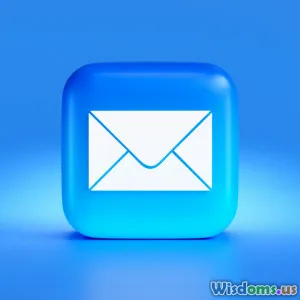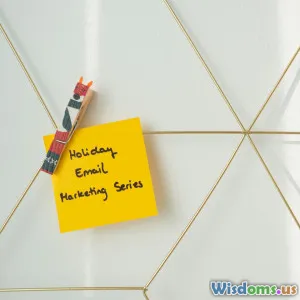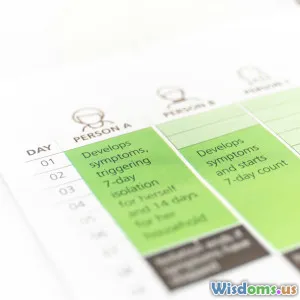
Unlock the Power of Curiosity in Your Email Subject Lines
17 min read Discover how curiosity-driven email subject lines can boost open rates and engagement for your campaigns. (0 Reviews)
Unlock the Power of Curiosity in Your Email Subject Lines
What makes you pause while scrolling through your inbox? More often than not, it's curiosity—a spark that ignites with the promise of the unknown. Marketers and communicators know the immense value of a well-crafted subject line, yet the secret sauce many overlook is the potent, almost magnetic force of curiosity. In today’s noisy, hyper-competitive digital landscape, leveraging curiosity can be the difference between an opened email and one relegated to the trash.
Let’s explore research-backed tactics and actionable tips that can swiftly elevate your subject lines from forgettable to irresistible—without sacrificing reputation or clarity.
Understanding the Psychology of Curiosity

Curiosity is a fundamental human drive—an ancient urge hardwired into our brains. Psychologists like George Loewenstein have described curiosity as a feeling of deprivation when we recognize a gap between what we know and what we want to know. This gap, known as an "information gap," is the engine behind why headline styles like “You won’t believe…” or “What happens next will surprise you…” achieve such high engagement rates.
But curiosity isn’t just universal—it’s also nuanced. For instance, neuroscience research at the University of California, Davis, found not only that curiosity boosts activity in the brain's reward centers but also that it enhances memory retention. When subject lines trigger curiosity, our brains literally become more receptive, making readers far more likely to absorb the message behind the click.
Example: Take "The Reason Your Coffee Tastes Weird Lately" versus "Explore Coffee Taste Variations." The former raises a question or implies a secret, tickling the information gap. The latter merely states a bland topic. The magical element? It’s not about trickery; it’s about offering a promise that the next click will lead to value, surprise, or story.
Key Insight: Foster natural intrigue, not deception. Disappointing or misleading curiosity undermines trust—and once eroded, your brand might never get it back.
Anatomy of a Curious Subject Line
Let’s dissect what makes a subject line invoke irresistible curiosity. While formulas abound, the most effective subject lines balance three key elements:
1. The Information Gap Create a subtle gap, hinting that the answer or resolution exists—but the reader must act (click!) to satisfy their curiosity.
- "Can We Pick Your Brain for 2 Minutes?"
- "You Might Be Missing This in Your Workflow…"
Each suggests undisclosed information behind the open.
2. The Unfinished Story Begin a narrative that compels completion.
- "What Happened at Our Office Party Changed Everything…"
- "She Tried This One Strategy and Couldn’t Believe the Results"
3. Personal Relevance and Specificity The secret is relevance. A curious subject line for a financial advisor will look vastly different from one for a pet supply store.
- "Meet the Lab That Invented a New Kind of Pet Toy" (for pet product consumers)
- "How This Tax Trick Saved Me $2,000 — Could It Work for You?" (for finance subscribers)
Tip: Combine curiosity with specificity. Vague curiosity (“Guess What?”) gets ignored. Aim for a sense of something intriguing—just out of reach, yet within the reader’s world.
Debunking Myths: Curiosity vs. Clickbait
Some marketers recoil at the idea of building curiosity, worried it’s synonymous with slimy clickbait. But these are not one and the same. Clickbait relies on manipulation and under-delivery. Curiosity, as wielded by reputable brands, is about earning trust through genuine intrigue.
Clickbait Example: “She Opened Her Fridge…What Happened Next Shocked Her!” (delivers little value or no meaningful story)
Curiosity-Driven Email: “How a Refrigerated Ingredient Improved My Week” (teases insight, hints at value, and respects the reader)
How to Avoid Clickbait:
- Deliver What You Promise: Match the body content to the curiosity gap you set up.
- Stay Relevant: The topic must matter to your audience.
- Respect the Reader: Use intrigue to inform, not to manipulate.
A famous example is BuzzFeed’s evolution. Once a synonym for clickbait, they shifted to adding higher-quality stories behind their catchy headlines—still curiosity-driven, but now supported with substance.
Real-World Success: Brands Winning with Curiosity

Some of the world’s most successful digital brands consistently leverage curiosity. Here’s how a few industry leaders do it, and what makes their campaigns stand out:
BuzzFeed
BuzzFeed built its empire with irresistible headlines that stoked the reader’s desire to uncover secrets—“27 Things Only People Who Work From Coffee Shops Will Understand.”
What We Learn: Using the insider knowledge angle appeals to curiosity, especially in communities with a shared experience.
Grammarly
Grammarly often sends emails with compelling subject lines like, “How Strong Is Your Vocabulary?” or “What’s Your Writing Score?” These urge recipients to measure themselves, a known curiosity trigger.
What We Learn: When subject lines suggest self-discovery (quizzes, scores, personal challenges), open rates reliably climb.
Duolingo
Known for catchphrases like “You’re on a 7-day streak! Can you keep it going?” or “You’re so close—one lesson away!” Duolingo artfully cultivates curiosity about what reward or acknowledgment waits inside.
What We Learn: Use specific numbers, streaks, or challenges to turn curiosity into ongoing engagement.
Fact: According to MarketingSherpa, emails with curiosity-driven subject lines have open rates 22% higher than basic, descriptive lines.
Crafting Curiously Effective Subject Lines: A Step-By-Step Method

Creating curiosity doesn’t happen by accident. Here’s a proven method to consistently brainstorm powerful, curiosity-driven subject lines for any campaign:
1. Know Your Audience Inside-Out
Understand their pain points, interests, and what keeps them up at night. Use surveys, polls, and your own customer support logs for insight.
Example: A SaaS company learns via helpdesk logs that users struggle with onboarding. A curiosity gap subject line: “What Most Users Miss During Onboarding” addresses a known concern—then invites the click.
2. Uncover Your Core Message or Offer
What is the most surprising, little-known, or counterintuitive aspect of your email content?
- If offering a product, ask, “What’s unique about it?”
- Sharing insights? “What do most people get wrong about this topic?”
3. Tease, Don’t Reveal
Avoid giving away the punchline in the subject line. Instead, pose a question or dangle a hint.
Instead of: “Get 50% Off Socks Today!”
Try: “Why Are Socks Half Price This Week?”
4. Play with Structure and Style
Some attention-grabbing formats:
- The Question: “Are Your Habits Holding You Back?”
- The How/What: “How This App Doubled My Productivity”
- The Hidden Secret: “Most Travelers Miss This Airport Trick”
- The Missing Piece: “One Thing You Forgot to Do Last Week”
5. Test, Refine, Evolve
A/B test subject lines to learn what triggers curiosity and results in action from your unique audience. Continuously refine the winning formulas—consumer curiosity changes over time.
Pitfalls to Avoid When Fueling Curiosity

While curiosity can skyrocket engagement, mishandled, it can damage trust and long-term effectiveness. Here are four common pitfalls and how to sidestep them:
-
Overhyping with No Payoff
- If the body of your email doesn’t deliver, you’ll lose subscribers faster than you gained them.
- Tip: Proofread your email for promised answers. Is the payoff worth the click?
-
Being Too Vague
- Overly generic lines (“Guess What Happened?”) feel spammy or untrustworthy.
- Tip: Contextualize the curiosity with relevant details.
-
Ignoring Audience Values
- Irrelevant or inappropriate teases may result in negative sentiment.
- Tip: Only spark curiosity in ways that match your brand and your audience’s interests.
-
Bombarding with Excessive Mystery
- If every email tries too hard, it reads as desperate or exhausting.
- Tip: Mix straightforward updates with curiosity-driven content for best effect.
Advanced Strategies: Leveraging Data and Personalization to Stoke Curiosity

In a saturated market, the most tempting subject line is one tailored uniquely to your reader. Modern technology lets you blend curiosity with personalization for dramatic results.
Dynamic Fields Include specifics:
- “Tom, Your June Statement Has a Hidden Surprise”
- “Is This Habit Slowing You Down, Rachel?”
Behavioral Triggers Base curiosity on previous actions:
- “We Noticed You Left Something in Your Cart…But That’s Not All”
- “6 Ways Other Subscribers Are Doing Better With Your Plan”
A/B Testing with AI Leading tools such as Mailchimp, HubSpot, and Persado use algorithms that evaluate which curiosity-driven subject lines garner the best response for specific segments.
Fact: Campaign Monitor found segmented and personalized subject lines delivered up to a 26% higher open rate compared to generic sends. Personal context supercharges curiosity.
Ethical Curiosity: Building Long-Term Reader Relationships

While the thrill of a great open rate may be tantalizing, lasting success stems from trust. Ethical curiosity blends intrigue with authenticity:
- Be Transparent: Give enough information so readers know it’s from a reputable source.
- Align with Value: Ensure that following the curiosity gap leaves the reader feeling informed, satisfied, or delighted.
- Encourage Conversation: When possible, use curiosity to open dialogue—not just route to a landing page. Subject lines like “What Inspired You This Month?” invite sharing and deepen loyalty.
Consider the long-haul. A consistently positive curiosity payoff cements your inbox spot as one not to be missed.
Curiosity by Context: How Various Industries Optimize the Approach

The magic of curiosity isn’t one-size-fits-all; it morphs based on industry norms and audience expectations. Let’s break down tailored approaches for three distinct fields:
E-Commerce
Subject lines like:
- “Forgotten Treasure: Your Cart Awaits”
- “The One Accessory You Didn’t Know Your Kitchen Needed”
Curiosity here fuels impulse and discovery, perfect for short buying cycles.
B2B/Professional Services
- “What Top CFOs Are Doing Differently in 2024”
- “This Overlooked Rule Cost Me $10,000”
Leverage authority, insight, and stakes. Curiosity should promise relevance as well as intrigue.
Nonprofits
- “A Story From Our Volunteer That Moved Us”
- “How 12 Cans Changed a Neighborhood”
Use curiosity to invite empathy, inspiration, and connection. Narrative-driven intrigue aligns with mission-based storytelling.
Ten Curiosity-Fueled Subject Lines That Made History

- “Is this the hottest career in America?” (LinkedIn: Job suggestion campaign)
- “They Did What to Save $5,000 on Flights?” (Travel aggregator)
- “You’re the Reason We Made This Change…” (Online retailer)
- “Which City Should You Move To Next?” (Online quiz content)
- “Don't Open This Email (Unless You Want a Surprise)” (Consumer goods promo)
- “7 Foods Nutritionists Refuse to Eat” (Health publication)
- “See Why Everyone’s Talking About Our Demo” (SaaS product)
- “Can You Spot the Difference?” (E-commerce visual test)
- “Have You Tried the Skincare Craze from Korea?” (Beauty brand)
- “Your Year in Review: Can You Guess Your Most Popular Habit?” (Behavioral tracking app)
Many of these examples generated open rates above 40%, well beyond industry averages.
Top Tools and Templates for Creating Curiosity-Driven Subject Lines

Take your new knowledge from theory to practice by experimenting with these:
Tools
- SubjectLine.com: Tests deliverability and effectiveness.
- Mailchimp Subject Line Researcher: Analytics on open rates and phrase suggestions.
- CoSchedule Headline Analyzer: Scores curiosity, sentiment, and skimmability.
Plug-and-Play Templates
- “The Real Reason {Benefit/Problem} Happens”
- “What Most People Get Wrong About {Topic}”
- “Your Quick Guide to Why {Situation} is Changing in {Year}”
- “Do You Know About {Unexpected Topic}?”
- “I Almost Didn’t Send This, But…”
- “{Customer Name}, This Number Surprised Us”
Experiment, track results, and refine—great subject lines are crafted, not stumbled upon.
Curiosity remains email marketing’s most reliable secret weapon. When wielded with relevance and ethics, a mystery-laced subject line can consistently unlock dramatically higher open rates and deeper subscriber trust.
In a world where inboxes fill faster than ever, remember: the right question in your subject line isn’t just an invitation—it’s a door they’re already itching to open.
Rate the Post
User Reviews
Popular Posts



















